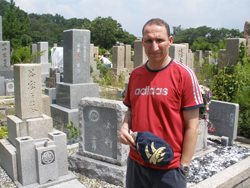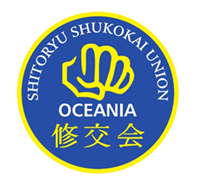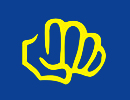
The Shito-ryu Shukokai Karate-do Union is a worldwide acting organisation. Its aim is to provide the art of Shito-ryu Shukokai Karate do.
It is one of the most dynamic and successful Karate schools. Shukokai’s Japanese roots centered on the universities of Osaka and Kyoto and their students established the school as a fast and powerful style. Shukokai was the brainchild of TANI Chojiro sensei. Sensei Tani began studying Goju Karate while at Junior High school. When he entered the Doshisha University, he began studying Shito Ryu Karate. Upon receiving his Menko (Teachers Certificate) from Kenwa Mabuni, Sensei Tani began teaching Tani-Ha Shito Ryu at his own Dojo in1948. He proudly hung a wood carved sign above the entrance which said “Shukokai.”
Sensei Tani sought to perfect his style by studying the mechanics of the human body and developed techniques which can be delivered with maximum efficiency. Over a long period of time Sensei Tani evolved and developed Shukokai. He always laid stress on the importance of etiquette, discipline and mental control, and was at pains constantly to promote the improvement of technique.
After the death of the founder of Shito-ryu Shukokai, Mr. Chojiro Tani on the 11th of January 1998, there was a conference of the Shukokai general Council on the 28th of June 1998 to determine the future continuance Shukokai and the Tani-ha sect of Shito-ryu.
The proceedings of the conference were recorded and minuted, and it was decided the Shukokai name would become the “Shito-ryu Shukokai Karate-do Union”, the proper successor to the original Shukokai organisation, founded by Mr. Tani. It was also decided and agreed that the first leader of this new organisation, would be Mr. Haruyoshi Yamada (9th Dan Hanshi)
The word Shukokai is somewhat difficult to translate. It is easier to break the word down into its components to obtain a better understanding of what it means.
- Shu can be translated to mean; Training
- Ko can be translated to mean; Many people meeting; crossing; intersection; come together.
- Kai can be translated to mean; Association; train under one roof
Being a direct descendent of Shito-Ryu, Shukokai inherits the characteristics of both the Naha-te and Shuri-te styles of Okinawan Karate. Kenwa Mabuni merged the techniques and principles of the styles he learned from his teachers Kanryu Higaonna, and Anko Itosu to form his Shito-Ryu style of Karate. As such, Shukokai combines the circular breathing techniques from Naha-te and the quick linear movements of the Shuri-te styles.
This is apparent in the katas performed within Shito-Ryu Shukokai. Katas like Sanchin, Tensho, and Suparunpei are handed down from the Naha-te traditions, while katas like Annanko, Matsukaze, and Bassai-Dai are handed down from the Shuri-te traditions. Upon close examination, one can see the similarities between Tensho, Sanchin, and Suparunpei, and the similarities between Bassai-Dai, Annanko, and Matsukaze, and what makes the Naha-te katas different from the Shuri-te katas. Also notable is the relatively high number of katas within Shito-Ryu Shukokai. This is a direct result of Master Mabuni’s experience with both the Naha-te and Shuri -te styles, and the reason why he was renowned throughout Japan as the foremost expert on kata.

Another attribute that distinguishes Shito-Ryu Shukokai Karate from other styles is the execution of techniques. While Shito-Ryu Shukokai shares many of the same punches, kicks, and blocks found in other popular styles of Karate, it is in how these are executed that sets Shito-Ryu Shukokai apart. Sensei Tani made his greatest contributions to the style by continually refining each technique to the highest degree, essentially re-defining the basics that had been practiced for centuries. Both made the study of body mechanics their primary focus with the end result being the delivery of the greatest impact with the least amount of effort. Another defining characteristic is that each technique must be combat effective. Sensei Tani believed that a technique, no matter how powerful, was useless if it could not be delivered under combat situations. His philosophy was that the outcome of a confrontation should be decided in a single technique, “one hit one kill”, as per the way of the samurais of old.
This drove him to continually modify and test his technique throughout the course of his life with the end result being the traditional, Shito-Ryu Shukokai. Every technique executed within Shito-Ryu Shukokai has these defining principles at its very core, yet combat effective style of Karate

